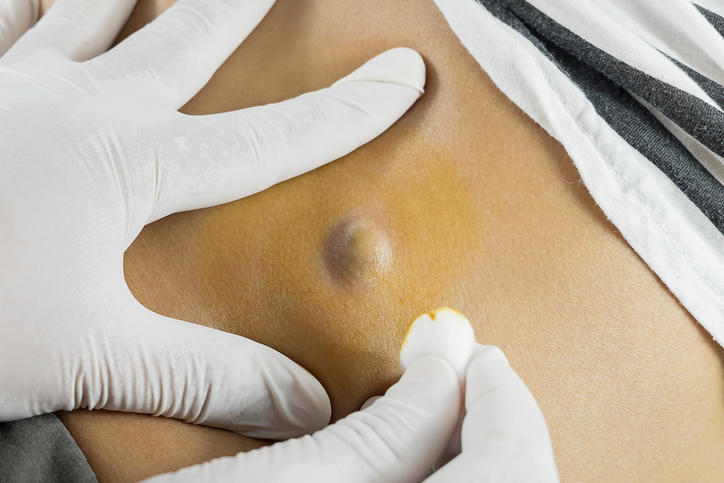
A Cyst on the Foot or Wrist: What You Should Know
Discovering a lump under your skin—especially on the wrist or foot—can be worrying. While it’s natural to feel concerned, most of these bumps turn out to be harmless cysts. Here’s what you need to know about them, when to seek medical advice, and how they can be treated.
What Is a Cyst?

A cyst is a small sac beneath the skin filled with fluid or a thicker substance. Though the word may sound alarming, cysts are generally benign. They can form in many areas of the body, come in different sizes, and usually cause little or no pain.
Common Types of Cysts
-
Sebaceous (Epidermoid) Cysts: Small, round lumps just beneath the skin, usually painless and filled with a thick, oily material. They often need no treatment unless they become inflamed or bothersome.
-
Synovial Cysts: Found near joints such as the wrist, foot, knee, or hip. They may result from repetitive movement or injury and can sometimes resolve on their own. Painful or persistent ones may require minor surgery.
When to Be Concerned

Most cysts are harmless, but certain warning signs should not be ignored. See a doctor if you notice:
-
Redness or swelling (possible infection)
-
Pain or tenderness
-
Fever alongside a cyst
-
Rapid growth or changes in shape
-
Difficulty moving a joint near the cyst
What to Do If You Find a Cyst
-
Don’t squeeze or pop it—this can lead to infection.
-
Monitor it—many small, painless cysts remain stable and need no treatment.
-
Seek medical advice if the cyst becomes painful, inflamed, or starts changing.
Treatment Options

Treatment depends on the type and severity of the cyst:
-
Drainage: A doctor may drain larger or infected cysts.
-
Surgical removal: Recommended for cysts that persist or interfere with daily life.
-
Medication: Antibiotics may be prescribed if infection is present.
Prevention Tips
While cysts can’t always be prevented, you can reduce your risk by:
-
Practicing good skin hygiene
-
Avoiding skin trauma or repetitive strain on joints
-
Keeping skin moisturized
-
Wearing protective gear during repetitive activities
-
Maintaining a balanced, nutrient-rich diet for healthy skin
When to See a Doctor
Consult a healthcare provider if the cyst is painful, grows rapidly, becomes red or swollen, causes fever, or affects movement. Early evaluation ensures proper treatment and peace of mind.
Bottom Line
Cysts are common and usually harmless, whether they appear on the skin or near a joint. While most require no treatment, being aware of concerning symptoms is key. If in doubt, consult a doctor to rule out complications and keep your health on track.
News in the same category


13 Early Signs of Kidney Failure (You Ignore Daily) | Symptoms of Kidney Failure

A 4-Year-Old Girl Nearly Lost Her Life Due to Diabetes, Parents Cried: “We Spoiled Her Too Much!”

These are the signs that he is cr…See moree

If your feet are swollen, it is a clear sign that… see more

7 Things Not to Do Before Taking a Shower to Prevent Stroke – Plus 2 Common Mistakes

10 Warning Signs Your Liver Might Be in Trouble

Lung Cancer Symptoms

Most People Have Had or Have This Cold Sore Virus, But Very Few Know How to Cure It – Here’s What You Need to Do!

These are the signs that he is cr… See more

5 Warning Signs of Breast Cancer That Many Women Ignore

Hibiscus Apple Cinnamon Tea with Lemon – A Delicious Detox Drink for Your Health

Everything You Need to Know About Eating Eggs Daily — Science-Backed Benefits & What to Watch For

25 Amazing Ways to Use Rosemary That Can Change Your Life

All DNA and RNA Bases Found in Meteorites: Life’s Origins May Be Cosmic

Doctor reveals the one thing you should avoid doing if you wake up during the night

Claim: a juice regimen reportedly cleared can:cer cells in 42 days

Top 3 Ways to Treat Tooth Decay with Guava Leaves – Simple and Cost-Effective

8 Signs That Your Body Is Crying for Help
News Post

From Foster Care to Fatherhood: One Man’s Mission to Keep Five Siblings Together

15 Deadly Kidney Signs You Must Catch Early

13 Early Signs of Kidney Failure (You Ignore Daily) | Symptoms of Kidney Failure

Japan’s Innovative Parenting Lesson Lets Teens Experience Pregnancy and Infant Care

A New Bird Just Appeared in Texas—and That’s Not a Good Thing

Unlock Garlic’s Hidden Powers: The Ultimate Guide to Transforming Your Health with Nature’s Superfood

Can Okra Water Unlock a Hidden Health Revolution for You? Discover the Secret Elixir

Can Kitchen Staples Unveil a Dazzling Smile in 5 Minutes?

How 15,000 Bikers Rallied in Germany to Fulfill a Dying Boy’s Dream

Nick Vujicic: Living Without Limbs, Inspiring Millions Worldwide

Grandma’s Shocking Secret to a Hollywood Smile: Guava Leaves Unveiled!

Mix Cloves with Vaseline: A Secret Nobody Will Ever Tell You (Thank Me Later)

The Giant Pink Rabbit of Italy: From Knitted Monument to Decaying Legacy

Gene Therapy Breakthrough: Restoring Hearing in Deaf Individuals via Single-Gene Repair

Giant Manta Ray Approaches Divers for Help in Removing Fishing Hooks

See the Difference: A Delicious Drink to Support Eye Health Naturally

Avocado, Hibiscus & Clove Smoothie: A Vibrant Blend for Energy, Digestion & Glow

Take Honey and Cloves After 50: Fix 13 Common Health Issues in One Week!
